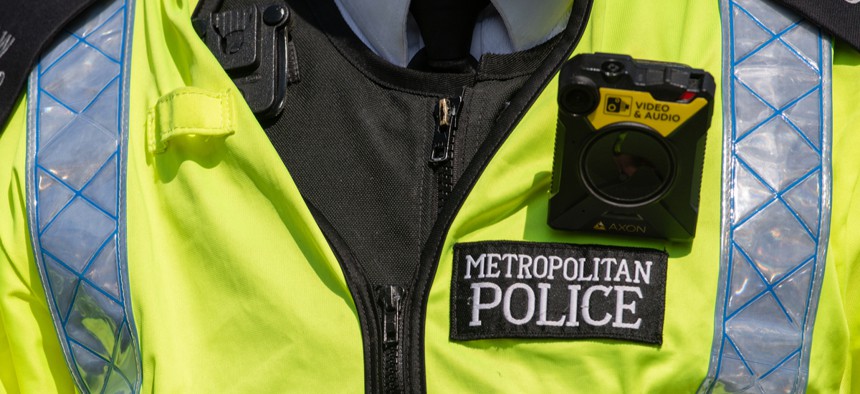Border Patrol Agents Might Get Body Cameras to Record Interactions With the Public

A close up of a body camera worn by a London Metropolitan police officer. John Gomez/Shutterstock.com
The agency is also interested in learning how body cameras could be integrated with its facial recognition program.
The Customs and Border Protection agency is considering giving Border Patrol agents body cameras to record interactions with the public—citizens and foreign nationals—at areas between designated ports of entry.
The agency has several checkpoints set up along the border between ports, though these areas generally have little to no IT infrastructure in place, including telecommunications and video recording.
As part of the Incident-Driven Video Recording System, or IDVRS, CBP is looking for rugged body-worn cameras that come with an easy-to-use video management system, as well as cloud storage capabilities.
“CBP anticipates storing most footage in CBP-owned data servers, but is also interested in cloud storage for evidentiary footage requiring long-term retention—defined as longer than two years,” according to a request for information posted Wednesday to FedBizOpps. “Footage stored will be secure, law enforcement sensitive data and should comply with all relevant federal laws, regulations and requirements. CBP also anticipates its users will require a cloud storage platform for frequently accessed files.”
Border Patrol agents will be able to turn the recording devices on and off manually. However, the cameras will be functionally on at all times, creating a 30-second buffer period that will capture events just prior to an agent turning on the recorder.
The cameras should be able to record for 12 hours at a time, including battery life and storage capacity.
The system will also allow authorized users to redact personally identifiable information and other “sensitive video and/or audio content” within the system, rather than needing to export to a separate piece of software. To ensure this capability isn’t abused, the system must also include a full audit trail showing all user activity.
Potential solutions must have a base level of cybersecurity that includes meeting Homeland Security and FedRAMP moderate impact level; requiring single sign-on using PIV cards; full encryption for all data, in motion or at rest; a restriction on external drive access; U.S.-based data storage; and round-the-clock security operations center support.
Beyond the baseline video and audio capture capabilities, CBP is also interested in how such a system could be incorporated into its biometric program.
The agency already manages an extensive facial recognition program that has been rolled out at airports, seaports and land crossings. As part of the RFI, the agency is interested in how its facial recognition and facial comparison systems could be integrated with body cameras. The specifics of how that would operate have been left to respondents to determine.
Initially, CBP plans to roll out a “targeted deployment of IDVRS to select known interdiction points where fixed camera systems do not record agent interactions with the public,” which the agency plans to determine based on “operational need,” according to the RFI.
Responses to the RFI are due by noon on Oct. 31.






